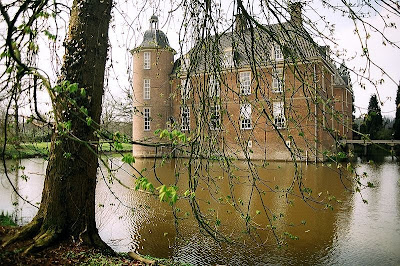skip to main |
skip to sidebar

So, it is not a castle. But it looks cool still the same. It is an English country house on the River Wye at Bakewell, Derbyshire.
 (The lands around it.)
(The lands around it.)
Have a nice day.
 Doorwerth Castle, it's in the Neterlands, and I'm busy. Goedendag
Doorwerth Castle, it's in the Neterlands, and I'm busy. Goedendag
Biljoen Castle,is located in the Netherlands. The castle almost certainly originated as a large farm that was first mentioned in 1076. Only in 1530 did Charles, Duke of Guelders built a castle out of it. The towers also date from this time. From the rest of the building it has not been confirmed what is original and what is not. The family Van Spaen rebuilt the castle around the 18th century into its current state.
In 1795 French troops were quartered in the castle. After they left the castle was plundered and the interior largely destroyed. The damage was restored with amongst others ornamental plaster and ceilingpaintings.

Goedendag

Fenis Castle is an Italian medieval castle located in the town of Fénis. (Funny how that works...) It is one of the most famous castles in Aosta Valley, and for its spectacular architecture and its many towers and battlemented (Yes, it is a real word.) a walls has become one of the major tourist attractions of the region.

The castle first appears in a document in 1242 A.D. as a property of the Viscounts of Aosta, the Challant family. At that time it probably was a simple keep surrounded by walls. It was from 1320 A.D. to 1420 A.D., under the lordship of Aimone of Challant and of his son Bonifacio of Challant, that the castle expanded to the actual appearance.

Under Aimone’s lordship the castle got its pentagonal layout, the external boundary wall and many of the towers. In 1392 Bonifacio of Challant began a second building campaign to build the staircase and the balconies in the inner courtyard and the prison. He also commissioned Piedmontese painter Giacomo Jaqueiro to paint frescoes on the chapel and on the inner courtyard. Under Bonifacio I the castle reached its greatest splendor: it was a rich court surrounded by a vegetable plot, a vineyard and a garden where the lord and his guests could relax.

The castle belonged to the lords of Challant until 1716, when Georges François of Challant had to sell it to Count Baldassarre Castellar of Saluzzo Paesana (*Snicker*) in order to pay his debts, and for the castle was the beginning of a period of decline. It was turned into a rural dwelling and became a stable and a barn.

In 1895 architect Alfredo d’Andrade purchased it and started a restoration campaign to secure the damaged structures. In 1935 a second campaign by De Vecchi and Mesturino completed the restoration and gave the castle the current appearance. The rooms were also provided with wood period furniture.
The castle is today owned by the Regional Council, which turned it into a museum.

Buon giorno


 Have a nice day.
Have a nice day.




 Goedendag
Goedendag









